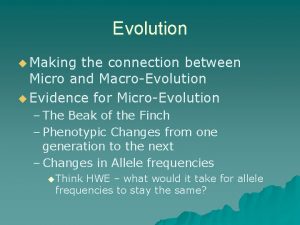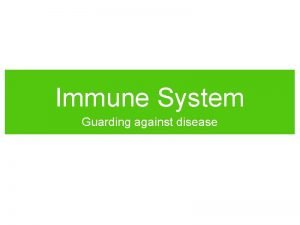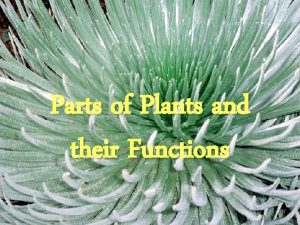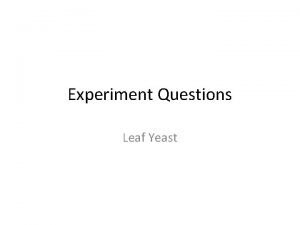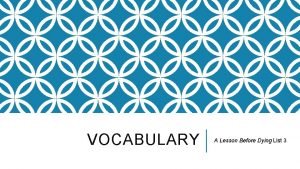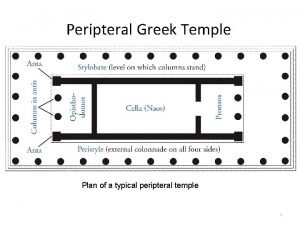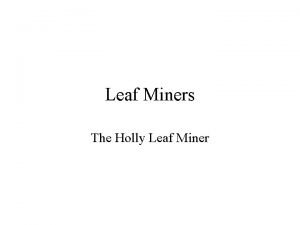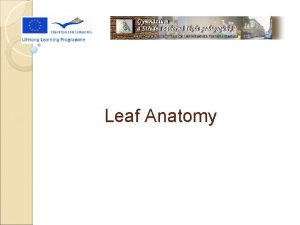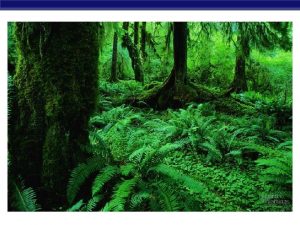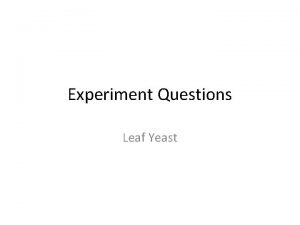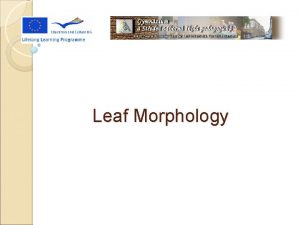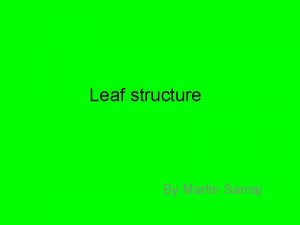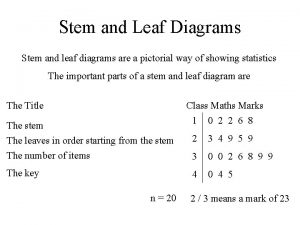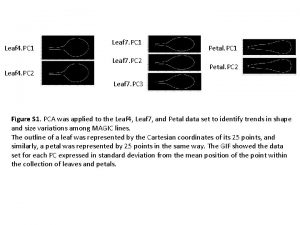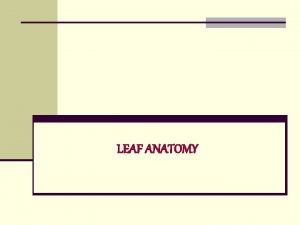Why Protect A Dying Leaf Chapter 42 Plant

























- Slides: 25

Why Protect A Dying Leaf?

Chapter #42 – Plant Anatomy & Nutrient Transport 7 Edition in Audesirk, and Byers th Chapter #24 – Plant Anatomy & Nutrient Transport • 42. 1 - How Are Plant Bodies Organized; How Do They Grow? p. 860 • 42. 2 - The Tissues and Cell Types of Plants? p. 862 • 42. 3 - The Structures, Functions of Leaves, Roots, & Stems? p. 865 • 42. 4 - How Do Plants Acquire Mineral Nutrients? p. 873 • 42. 5 - How Do Plants Move Water Upward from Roots to Leaves? p. 876

The Art and Science of Living Survive (live) Support the body Obtain water & nutrients Transport water & nutrients Obtain energy Grow and Develop Exchange gases P? rotection from Herbivory Reproduce

Angiosperms (Monocots and Dicots) • Flowering plants (called Angiosperms) are divided into two groups (monocots and dicots) based on the structure of their flowers, leaves, vascular tissue, roots, and seeds. A. Largest phylum of living plants. B. 250, 000 + species. C. Seeds enclosed by fruits.

Plant Anatomy Roots & Shoots • Root and shoot systems are made up of basic plant organs: roots, leaves, stems, flowers.

Root System Functions • Anchor plant. • Absorb water and minerals. • Store sugar as starch. • Transport materials • Produce some hormones. • Interact with soil microbes.

Shoot System Functions • Photosynthesis (primarily in leaves) • Transport of materials (water, minerals, sugars, and hormones among leaves, flowers, fruits, and roots) • Reproduction • Hormone synthesis

Angiosperms (Monocots and Dicots) Structure is used in classification • Monocots have one cotyledon (seed leaf) – e. g. grasses, lilies, palms, orchids • Dicots have two cotyledons (seed leaves) – e. g. deciduous trees (drop leaves in winter), bushes, many garden flowers

Flowers Monocots: flower parts in 3’s Dicots: flower parts in 4’s, 5’s, 6’s

Leaves Monocots: parallel veins in leaves Dicots: network of veins in the leaves

Stems Monocots: small vascular bundles scattered throughout the stem. Dicots: large vascular bundles arranged in a ring around the stem.

Roots Monocots: fibrous root system with no main tap root. Dicots: Main tap root, with smaller side roots branching off.

Seeds Monocots: single cotyledon; endosperm and cotyledon are separate. Dicots: two cotyledons; endosperm is contained in the cotyledon.

Plant Tissues Dermal Tissue - Epidermis - Periderm Ground Tissue - Parenchyma - Collenchyma - Sclerenchyma Vascular Tissue - Xylem - Phloem

Dermal Tissue: Epidermis • Covers flowers, seeds, fruit. • Secretes a waxy substance called cuticle (cuticular membrane hydrophobic) as waterproofing. • May produce special structures such as hairs (root hairs). Why?

Dermal Tissue: Periderm • Replaces epidermis on roots and stems of woody plants with age. • Composed mainly of thick, waterproof cork cells. • Protects stems and roots. • Anchor system (doesn’t absorb water & minerals).

Plant Tissues Parenchyma Collenchyma Sclerenchyma

Ground Tissue: Parenchyma • Non-dermal, nonvascular. • Thin-walled cells • Alive at maturity • Many functions, including photosynthesis, starch storage, hormone production.

Ground Tissue: Collenchyma • Flexible support tissue. • Elongated cells with irregular shapes and unevenly thickened walls. • Living at maturity.

Ground Tissue: Sclerenchyma • Support tissue. • Elongated cells with thick cell walls. • Dead at maturity. • Forms long fibers, or smaller sclerids (such as stone cells in pears).

Vascular Tissue: Xylem • Sclerenchyma fibers • Long, tube-like cells, joined end-to-end, that transport water and minerals from soil to leaves. • Two types of cells: tracheids (in conifers) and vessel elements (in flowering plants).

Vascular Tissue: Phloem • Tissue that transports dissolved sugars (sap) in a plant. • Two types of cells: • Sieve tubes (alive but no nucleus) • Companion cells

In Review. . Monocots

In Review. . Dicots

Why Protect A Dying Leaf?
 Andreas carlsson bye bye bye
Andreas carlsson bye bye bye Maple leaf and oak leaf homologous
Maple leaf and oak leaf homologous Leaf and non leaf procedure
Leaf and non leaf procedure Why we must save dying tongues
Why we must save dying tongues Dot
Dot Parts of the plants and their functions
Parts of the plants and their functions Function of plant leaf
Function of plant leaf Dont ask why why why
Dont ask why why why An attitude that is helpful in hospice work is
An attitude that is helpful in hospice work is A lesson before dying chapter 22
A lesson before dying chapter 22 Chapter 13 - death and dying
Chapter 13 - death and dying Tante lou
Tante lou Growth of leaf yeast experiment
Growth of leaf yeast experiment Plant introduction
Plant introduction Plant introduction in plant breeding
Plant introduction in plant breeding Plant introduction in plant breeding
Plant introduction in plant breeding Tronsmo plant pathology and plant diseases download
Tronsmo plant pathology and plant diseases download Tronsmo plant pathology and plant diseases download
Tronsmo plant pathology and plant diseases download Albugo eye
Albugo eye A lesson before dying vocabulary
A lesson before dying vocabulary Stages of dying
Stages of dying To an athlete dying young theme
To an athlete dying young theme The dying rooms
The dying rooms Atypical pneumonia
Atypical pneumonia Thank you lord you died for me
Thank you lord you died for me Plan of a typical greek theater
Plan of a typical greek theater

